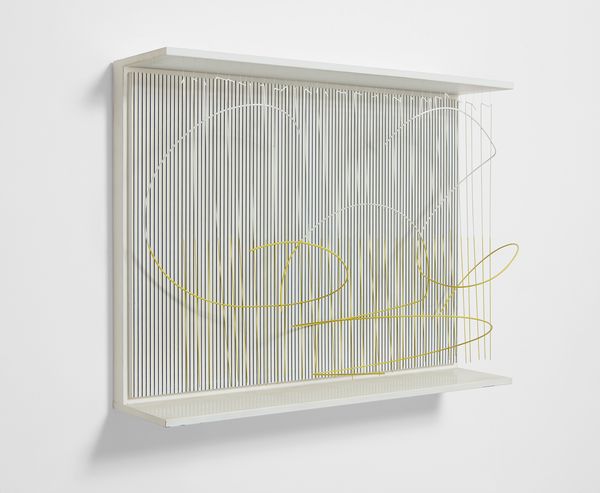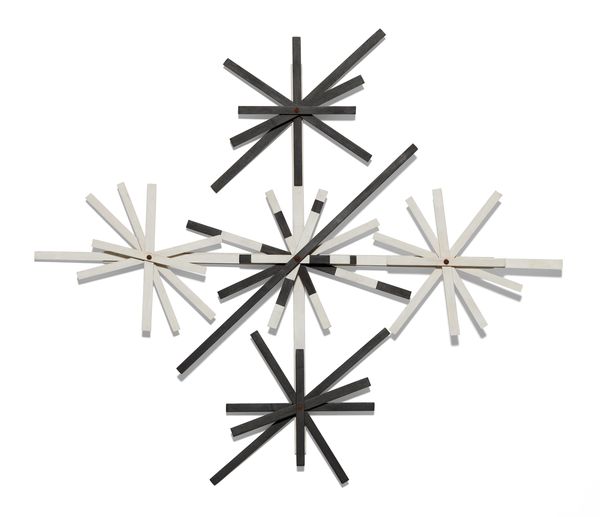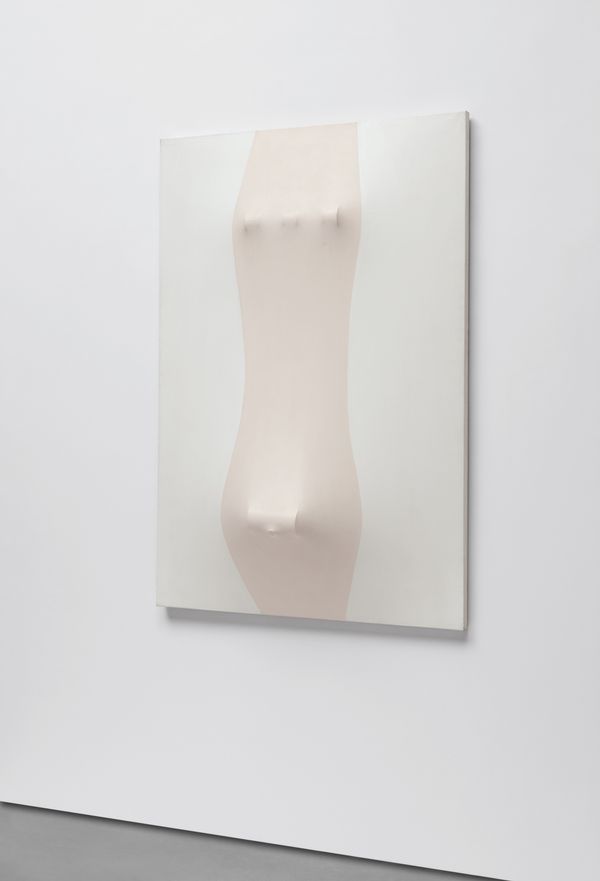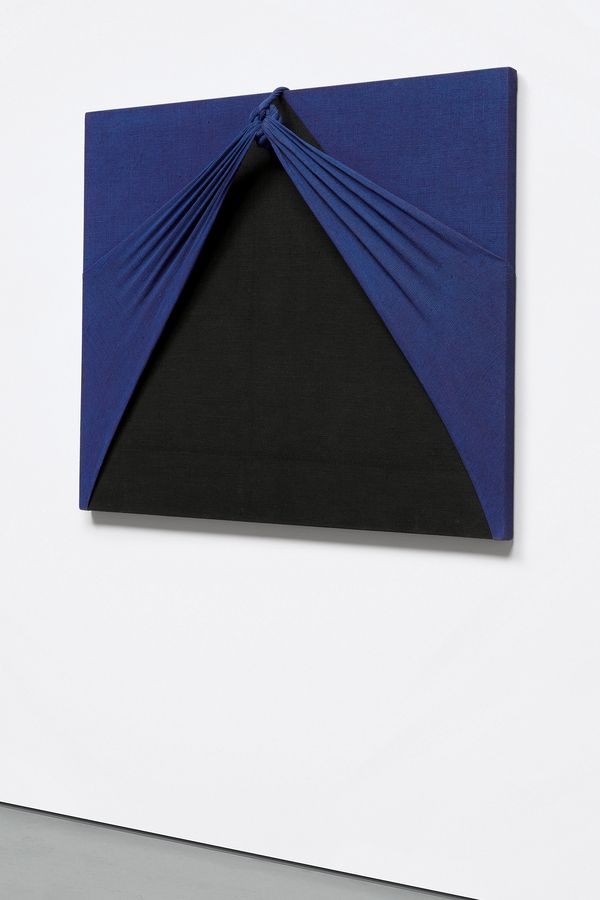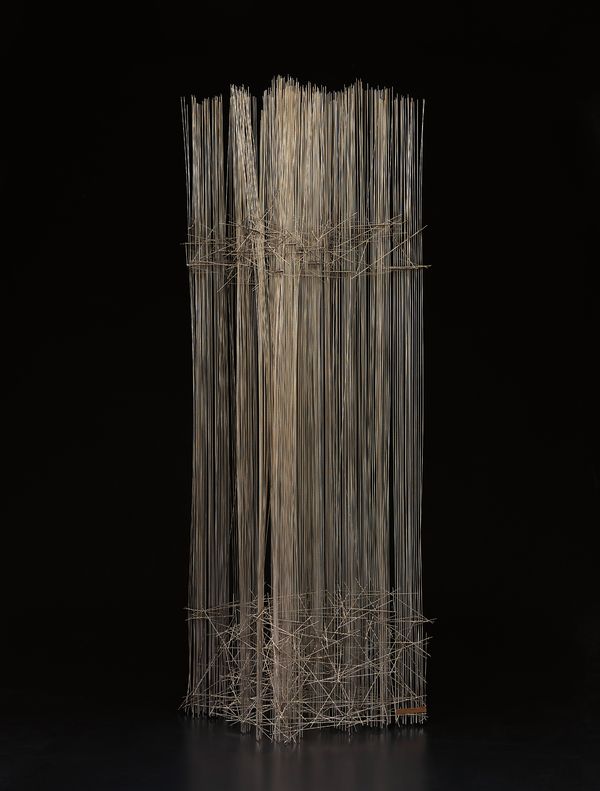Jesús Rafael Soto Escritura medio amarilla, 1977. Painted wood and metal rods with nylon strings.
Five modern forms from our upcoming Latin America sale in New York collectively break out of the traditional two-dimensional picture plane of painting—yet are intrinsically related to it. These works span the 1950s through the early 1990s across Cuba, Venezuela, Peru, Argentina and Brazil, and they combine a variety of mediums and technical practices in achieving their desired effects.
In breaking out of the traditions of typical wall-hung artworks, these pieces demonstrate immense skill and sophistication.
Sandú Darié Untitled (from the series 'Formas geométricas móviles'), circa 1950-1969. Painted wood assemblage.
Romanian-born Sandú Darié immigrated permanently to Havana in 1941, escaping the war in Paris where he had been studying. He is considered one of the foremost revolutionary Concrete artists, a movement that characterized the decade of the 1950s in Cuba. Although his early works reflected an expressionist tendency, Darié soon turned to geometric abstraction. In 1952, along with Mario Carreño and Luis Martínez Pedro, he founded the magazine Noticias de Arte—used as a platform to promote abstraction within Cuban modernism—quickly accelerating the consolidation of the Concrete movement.
This work, with its mechanical construction and moving parts, is a masterful example of Darié's novel style. As aptly elucidated by Abigail McEwen in Concrete Cuba – Cuban Geometric Abstraction from the 1950s, 2015, Darié "challenges the fixity of line and color, directing their movement dynamically beyond the frame, implicitly displacing art into life." Imbued with a geometric rigor reminiscent of Piet Mondrian's Neoplasticism, this elegant work compels viewers to engage with its movable components to create various star bursts of black and white. Untitled (from the series 'Formas geométricas móviles') is a masterwork that definitively denotes the pioneering theoretical scope of Cuban Concretism.
Sánchez broke free from the rectangular expectations of the painted canvas, yet she did not adhere strictly to Concrete art...
Zilia Sánchez Topologías eróticas, 1970. Acrylic on stretched canvas.
In 1952, shortly after studying at the National School of Fine Arts of San Alejandro in Havana, Zilia Sánchez exhibited at the Museum of Modern Art in Paris, and, in 1953, had her first solo exhibition at the Havana Lyceum. During this period, she traveled extensively between Havana, New York and Madrid, finding inspiration in a myriad of artists, such as Lucio Fontana and Eva Hesse, as well as her Cuban contemporaries, Amelia Peláez and Sandú Darié.
Soon Sánchez began creating works that employed canvases tightly stretched over hand‐molded wooden armatures, of which the above lot is a seminal example. These works explore the juxtaposition between feminine and masculine through formal abstraction and a distinctively sensual vocabulary. Yet, they remain elusive and unusual as Marta Traba aptly elucidates in Zilia Sánchez – Heróicas Eróticas en Nueva York, 2014: "Sánchez' works appear to transform an erotic paradigm premised on metaphoric interiority into one organized as literal exteriority, that is, into a poetics of surface itself." Sánchez broke free from the rectangular expectations of the painted canvas, yet she did not adhere strictly to Concrete art like many of the male artists from this period in Cuba. Topologías eróticas is amply proportioned, featuring a curved form in a rosy skin-like hue that is immediately evocative of the female form with its undulating curves and smooth surface. Unlike her contemporaries, Sánchez has never been fearful of referencing the body in her abstract works, creating powerful pieces that incite lust and deep sentiment in viewers.
Jesús Rafael Soto Escritura medio amarilla, 1977. Painted wood and metal rods with nylon strings.
Raised in the small regional capital of Ciudad Bolivar with limited exposure to art, Jesús Rafael Soto received a scholarship to study at the Escuela de Artes Plásticas y Aplicadas in Caracas from 1942-1947. During this time, Venezuela was undergoing societal and cultural shifts as a result of the ending of a thirty year period of dictatorial rule under Juan Vicente Gómez. This political change sparked developments towards modernization in an attempt to leave behind Venezuela's isolationist policies of the past. As a result, Soto participated in an emerging society that advocated for Venezuelan art to be elevated and recognized at the international level. Venezuelan artists like Soto began to shed the traditional regionalist style and became advocates for an abstract approach.
This group of Venezuelan artists and intellectuals would later reconvene in Paris in 1950. Post-war Paris attracted a myriad of European and Latin American intellectuals, many of whom were fleeing various forms of political instability in their home countries. The French were eager to reclaim Paris as the world’s art capital and therefore granted numerous scholarships, thus fostering a robust international art scene, of which Soto became an integral member, catapulting him into the international art scene. By combining geometric and organic forms, Soto began an exploration into animated kinetic abstractions. The above lot—a three dimensional assemblage built with a variety of textures and materials—immerses viewers through the interplay of repeating vertical lines intersected with curved hanging elements, creating a mesmerizing visual vibration.
Here we witness ..an undeniable sense of nostalgia for [Eielson's] homeland and concurrently a formal desire to break away from the two-dimensional picture plane.
Jorge Eielson Quipus 30B, 1991. Acrylic on burlap.
Jorge Eielson studied Pre-Columbian art and archaeology in Lima, where he became associated with Agrupación Espacio, a group of experimental architects and artists formed in 1947 that sought to create work in dialogue with their ancient Incan ancestors. However, as Peru was relatively isolated at the time, Eielson eagerly accepted a grant to study in Paris, eventually bringing him to Rome where he would permanently settle. During this seminal period in Eielson's career, he became closely acquainted with artists like Cy Twombly, Alberto Burri and Mimmo Rotella, yet his own work never fully aligned with any one movement, eschewing formal association with Minimalism and Conceptualism while simultaneously containing elements of both.
In 1963, Eielson would begin his seminal body of work: the quipus. The name quipu harkens back to his Peruvian identity and literally references an ancient Incan recording system in which various types of knots were used to measure and record data. In this series—of which the above lot is an important example—Eielson would knot, twist and braid pieces of fabric that he would use to overlay or incorporate with traditional stretched canvas. Here we witness a two-fold preoccupation in Eielson's work: an undeniable sense of nostalgia for his homeland and concurrently a formal desire to break away from the two-dimensional picture plane.
His development of an independent visual lexicon would catch the attention of the international art community, leading to an invitation to exhibit his quipus in the 1964 Venice Biennales. Quipus 30B brilliantly embodies the central tenets of this series, presenting a work that is at once both painting and sculpture. The elaborately twisted knot unites two forcefully stretched swaths of deep blue burlap, creating strong diagonals and imbuing the work with a dynamic sense of energy. The simple geometric forms contrast the three-dimensional quipu that juts off the picture plane and into space. There is an undeniable connection to the Spatial Concepts of Lucio Fontana, a fellow Latin American artist who chose Italy as his adopted country and whose iconic cuts would forever change the landscape of painting. Begun just a few years later, Eielson's quipus were conversely relatively unrecognized until recently. However, a major retrospective opening at the Museo de Arte de Lima on November 16, 2017 will catapult Eielson to his deserved place within art history by finally investigating and acknowledging his groundbreaking contributions to modern art.
León Ferrari Untitled, 1978. Stainless steel.
León Ferrari was a defining figure in Argentine conceptual art. As a young man, Ferrari studied engineering at the Universidad de Buenos Aires but quickly lost interest in pursuing a professional career in that field. After one of his children was diagnosed with a serious illness in the mid-1950s, Ferrari traveled to Italy where he began studying ceramics, sparking his profound interest in art. When he returned to Buenos Aires, he began to create sculptures in wood and various types of metal. In 1961, he presented a number of wire sculptures at the Van Riel Galería in Buenos Aires, evincing a preoccupation with the relationship between lines and space. Ferrari articulated these sculptures with knots and rings rather than soldering, utilizing materials like copper, silver, gold, palladium and tantalum. These works possess an exquisite linear grace, reflecting the artist's remarkable dexterity. Shortly afterwards, Ferrari began drafting delicate abstract drawings, which he exhibited extensively in Milan and Buenos Aires, juxtaposing them with the early wire sculptures. The venues included an exhibition in 1964 at the Musée d'Art Moderne in Paris, organized by the renowned art critic Jorge Romero Brest, then the Director of the Argentine Instituto Torcuato Di Tella, a center for the avant-garde.
Throughout the mid-1960s and into the 1970s, Ferrari's involvement with Romero Brest and the experimental Instituto Torcuato Di Tella fueled an intense phase within his oeuvre. This was during the advent of the Vietnam War, and Ferrari was deeply affected by the controversial societal issues of inequality, power and discrimination, as became evident in his work. He was actively involved in politics and continually denounced the dictatorial government of Argentina, participating in a movement against repression and torture by advocating for human rights. Unfortunately, this led to the disappearance of his son during the military coup and his family was forced to leave the country, seeking exile in Brazil in late 1976, where he would dedicate himself solely to his art.
In Brazil, he once again began exploring the possibilities inherent to wire sculptures. He changed methods, soldering the works in order to create straight lines that would contrast expansive voids. These works resemble architectural maquettes, harkening back to his days as an engineer. Light is an essential element to them, as the straight lines allow it to penetrate the sculptures and ultimately provide a sense of the infinite. In 2006, Aracy Amaral, the Curator at the Pinacoteca do Estado in São Paulo, described these sculptures as "linear galaxies, nuclei suspended in contained spaces or models of imaginary buildings." The above work, Untitled, 1978, is an extraordinary example of this sophisticated and intricate body of work that attests to the visual poetry that has positioned Ferrari as a defining figure in conceptual art, both in Argentina and abroad. He was recognized with the prestigious Golden Lion for Lifetime achievement Award at the 2007 Venice Biennale.
All five works will be on view at 450 Park Avenue from Saturday 18 November through the auction at 11am EST on Tuesday 21 November.
